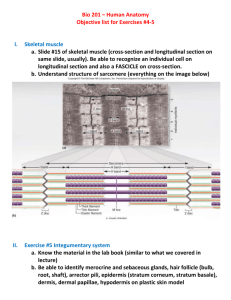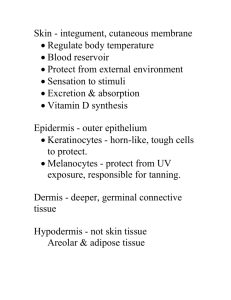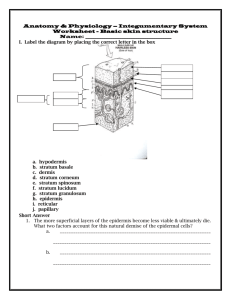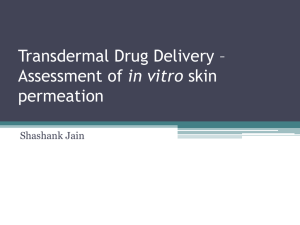Measuring depth depends on frequency in electrical skin impedance
advertisement
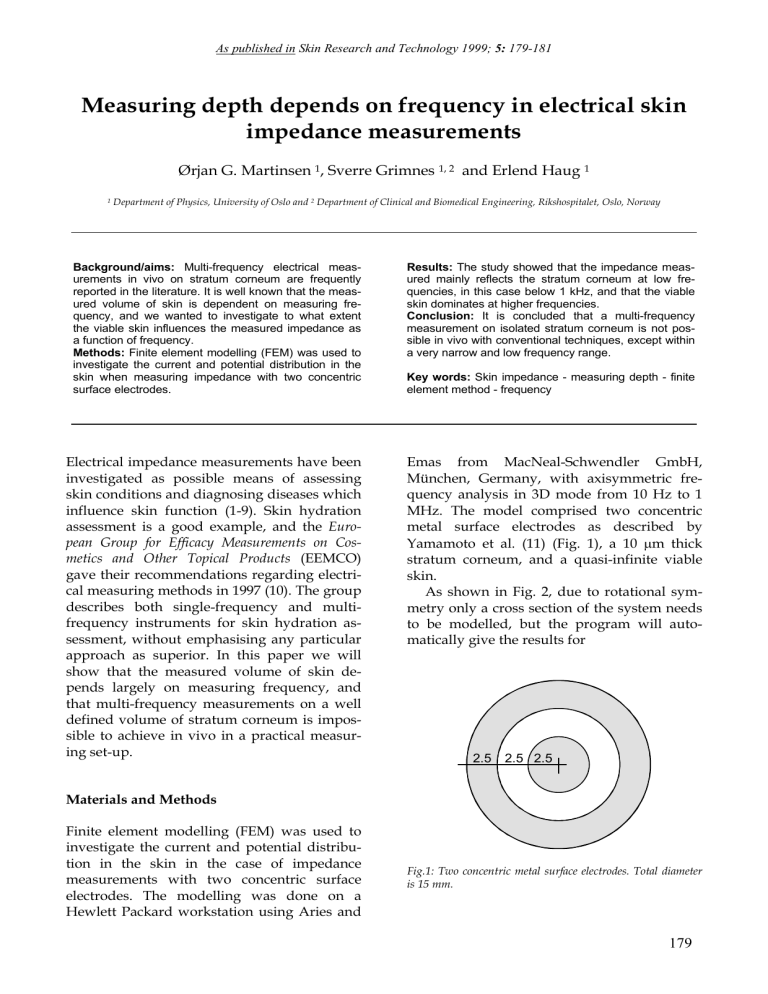
As published in Skin Research and Technology 1999; 5: 179-181 Measuring depth depends on frequency in electrical skin impedance measurements Ørjan G. Martinsen 1, Sverre Grimnes 1, 2 and Erlend Haug 1 1 Department of Physics, University of Oslo and 2 Department of Clinical and Biomedical Engineering, Rikshospitalet, Oslo, Norway Background/aims: Multi-frequency electrical measurements in vivo on stratum corneum are frequently reported in the literature. It is well known that the measured volume of skin is dependent on measuring frequency, and we wanted to investigate to what extent the viable skin influences the measured impedance as a function of frequency. Methods: Finite element modelling (FEM) was used to investigate the current and potential distribution in the skin when measuring impedance with two concentric surface electrodes. Electrical impedance measurements have been investigated as possible means of assessing skin conditions and diagnosing diseases which influence skin function (1-9). Skin hydration assessment is a good example, and the European Group for Efficacy Measurements on Cosmetics and Other Topical Products (EEMCO) gave their recommendations regarding electrical measuring methods in 1997 (10). The group describes both single-frequency and multifrequency instruments for skin hydration assessment, without emphasising any particular approach as superior. In this paper we will show that the measured volume of skin depends largely on measuring frequency, and that multi-frequency measurements on a well defined volume of stratum corneum is impossible to achieve in vivo in a practical measuring set-up. Results: The study showed that the impedance measured mainly reflects the stratum corneum at low frequencies, in this case below 1 kHz, and that the viable skin dominates at higher frequencies. Conclusion: It is concluded that a multi-frequency measurement on isolated stratum corneum is not possible in vivo with conventional techniques, except within a very narrow and low frequency range. Key words: Skin impedance - measuring depth - finite element method - frequency Emas from MacNeal-Schwendler GmbH, München, Germany, with axisymmetric frequency analysis in 3D mode from 10 Hz to 1 MHz. The model comprised two concentric metal surface electrodes as described by Yamamoto et al. (11) (Fig. 1), a 10 µm thick stratum corneum, and a quasi-infinite viable skin. As shown in Fig. 2, due to rotational symmetry only a cross section of the system needs to be modelled, but the program will automatically give the results for 2.5 2.5 2.5 Materials and Methods Finite element modelling (FEM) was used to investigate the current and potential distribution in the skin in the case of impedance measurements with two concentric surface electrodes. The modelling was done on a Hewlett Packard workstation using Aries and Fig.1: Two concentric metal surface electrodes. Total diameter is 15 mm. 179 As published in Skin Research and Technology 1999; 5: 179-181 total impedance. Because of symmetry, the stratum corneum was mathematically treated as an assembly of concentric rings, each being one element wide, and the impedance of the stratum corneum was found by integrating over these rings. This calculation is of course only correct if the current in the stratum corneum is restricted to the cross section given by the boundaries of the electrodes, and that the current density is homogenous in this cross section. These assumptions may however be applied in this case because of the large size of the electrodes and the large spacing between them as compared to the thickness of the stratum corneum. 0.01 mm 30 mm 40 mm Fig.2: Finite element model. 100 Contribution from viable skin [%] 90 Results 80 70 60 50 40 30 20 10 0 1 2 3 4 5 6 Log frequency [Hz] Fig.3: Relative contribution from viable skin as a function of frequency. the total 3D system. In this cross section, the stratum corneum was modelled with 908 elements, and the viable skin with 2263 elements. At a distance farther than 3 mm from the outer electrode, the current density in the stratum corneum is negligible and the stratum corneum was therefore not modelled in order to reduce the number of elements, and hence the processing time. A constant voltage was applied to the outer electrode, and the inner electrode was connected to ground. The edges of the electrodes were made slightly round (r = 10 µm) in order to avoid singularities in the calculations; the material constants, i.e. resistivity and relative permittivity were taken from Yamamoto and Yamamoto (12). The program calculates the potential and current density in each node of the model. In order to assess and calculate the contribution of the viable skin at different frequencies, the impedance in the stratum corneum under each electrode was calculated and compared to the The results from the FEM calculations showing the relative contribution of the viable skin to the skin impedance measured at different frequencies, are given in Fig.3. The results clearly show that the impedance measured mainly reflects the stratum corneum at low frequencies, in this case below 1 kHz, and that the viable skin dominates at higher frequencies. At 1 MHz the stratum corneum only accounts for 5.4 % of the measured impedance. In the case of a more hydrated stratum corneum, e.g. after treatment with a skin moisturiser, the influence from the stratum corneum is even less. Discussion The non-invasive measurement of skin impedance is influenced from a volume of the skin having boundaries that are dependent largely on the measuring frequency. High frequency measurements in general reflect the deeper, living layers of the skin, while low frequency measurements are dominated by the stratum corneum. Electrode geometry, of course, influences this behaviour to some extent, but the general principle remains the same. In order to focus high frequency measurements on the stratum corneum, the size of the electrodes as well as their separation must be kept small compared to the thickness of the stratum corneum (13). Since this thickness is about 10-20 micrometers for most skin sites, this is totally 180 As published in Skin Research and Technology 1999; 5: 179-181 unrealistic due to the risk of short circuiting the electrodes on the skin surface. A multi-frequency measurement on isolated stratum corneum is not possible in vivo with conventional techniques, except within a very narrow and low frequency range. Hence, the use of such measurements can not be endorsed, unless it can be verified that the experimental set-up enables an isolation of the stratum corneum in some way. References 1. 2. 3. 4. 5. 6. Ollmar S. Methods for information extraction from impedance spectra of biological tissue, in particular skin and oral mucosa – a critical review and suggestions for the future. Bioelectrochemistry & Bioenergetics 1998: 45: 157-160. Nicander I, Ollmar S, Lundh Rozell B, Emtestam L. Allergic contact reactions in the skin assessed by electrical impedance – a pilot study. Skin Research and Technology 1997: 3: 121-125. Lahtinen T, Tirkkonen A, Nuutinen J, Tenhunen M, Nuortio L, Usenius T, Alanen E. Detection of subcutaneous fibrosis by electrical bioimpedance. Proc. IX Int. Conf. Electr. Bio-Impedance 1995: 315-318. Serup J, Winther A, Blickmann CW. Effects of repeated application of a moisturiser. Acta. Derm. Venereol. (Stockh.) 1989: 69: 457-459. Serup J, Jemec GBE (eds.). Handbook of non-invasive methods and the skin. CRC Press, Boca Raton: 1995. Kontturi K, Murtomäki L, Hirvonen J, Paronen P, Urtti A. Electrochemical characterisation of human skin by impedance spectroscopy: The effect of penetration enhancers 1993: 10(3): 381-385. 7. 8. 9. 10. 11. 12. 13. Martinsen Ø.G., Grimnes S., Karlsen J.: An instrument for the evaluation of skin hydration by electrical admittance measurements. Innov. Tech. Biol. Med., 14(5), 588-596, 1993. Martinsen Ø.G., Grimnes S., Karlsen J.: Electrical methods for skin moisture assessment. Skin Pharmacol., 8(5), 237-245, 1995. Martinsen Ø.G., Grimnes S., Henriksen I., Karlsen J.: Measurement of the effect of topical liposome preparations by low frequency electrical susceptance. Innov. Tech. Biol. Med., 17(3), 217-222, 1996. Berardesca E. EEMCO guidance for the assessment of stratum corneum hydration: electrical methods. Skin Research and Technology 1997: 3: 126-132. Yamamoto Y, Yamamoto T, Ozawa T. Characteristics of skin admittance for dry electrodes and the measurement of skin moisturisation. Med. Biol. Eng. Comput. 1986: 24: 71-77. Yamamoto T, Yamamoto Y. Electrical properties of the epidermal stratum corneum. Med. Biol. Eng. 1976: 14: 151-158. Grimnes S., Martinsen ØG, Mørk C. Can skin hydration be estimated from electrical measurements? Proc. 11th Int. Symp. Bioeng. Skin, Skin Research and Technology, 2(4), 213, 1996. Address: Ørjan G. Martinsen Department of Physics University of Oslo P.O.Box 1048 Blindern N-0316 Oslo, Norway Phone: (+47) 22 85 64 74 Fax: (+47) 22 85 64 22 Email: ogm @ fys.uio.no 181
